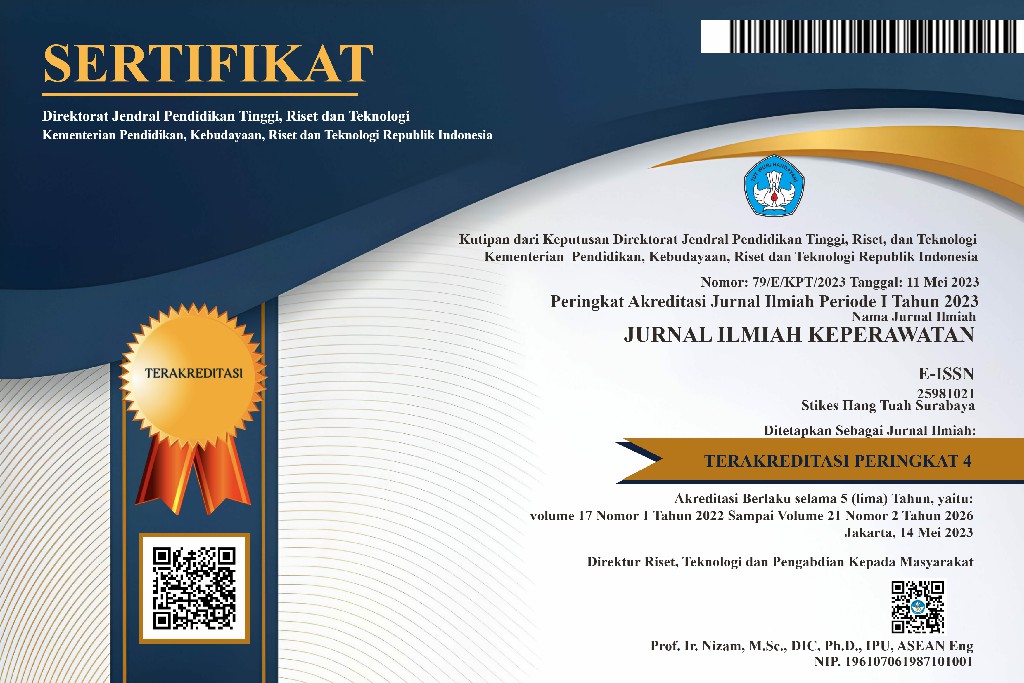Aspek Sentuhan Dalam Terapi Kelompok Terapeutik Untuk Meningkatkan Rasa Percaya Pada Bayi Usia 12-18 Bulan: Case Report
DOI:
https://doi.org/10.30643/jiksht.v15i1.84Keywords:
Infant, Touch, Therapeutic Group TherapyAbstract
Infancy is period of early life which basic abilities will determine success in the next phase. In this phase, the aspect of psychosocial development that must be achieved is to have a sense of trust, both for oneself, other people and the world around them. This study aims to find out how the application of therapeutic group therapy in increasing trust in infants and focus on aspects of touch. The method used is the case study. The results of this study indicate that the strengthening of touch in Therapeutic Group Therapy is able to foster and increase trust in infants in accordance with their psychosocial development tasks. Nurses as therapists need to emphasize this by encouraging mothers to not only give praise when the baby is successfully carrying out the task being trained, but also accompanied by physical affection sign such as touching, stroking, kissing and hugging the baby.
Keywords: Infant, Touch, Therapeutic Group Therapy
Downloads
References
Albers, E. M., Riksen-Walraven, J. M., & de Weerth, C. (2010). Developmental stimulation in child care centers contributes to young infants’ cognitive development. Infant Behavior and Development, 33(4), 401–408. https://doi.org/10.1016/j.infbeh.2010.04.004
Ardiel, E. L., & Rankin, C. H. (2010). The importance of touch in development. Paediatrics and Child Health. https://doi.org/10.1093/pch/15.3.153
Bader, L. R., Fouts, H. N., & Jaekel, J. (2019). Mothers’ feelings about infants’ negative emotions and mother-infant interactions among the Gamo of Southern Ethiopia. Infant Behavior and Development, 54(April 2018), 22–36. https://doi.org/10.1016/j.infbeh.2018.09.005
Baker-Smith, K., & Moore, K. A. (2001). Early onset of social anxiety: Impact of Erikson’s stages of psychosocial development. 1st Annual Conference of the Australian Psychology Society’s Relationships Interest Group, (January 2001), 19–23.
Bernard, H., Burlingame, G., Flores, P., Greene, L., & Joyce, A. (2007). Practice Guidelines for Group Psychotherapy, 85. https://doi.org/10.1521/ijgp.2008.58.4.455
Cates, C. B., Dreyer, B. P., Berkule, S. B., White, L. J., Arevalo, J. A., & Mendelsohn, A. L. (2012). Infant communication and subsequent language development in children from low-income families: The role of early cognitive stimulation. Journal of Developmental and Behavioral Pediatrics, 33(7), 577–585. https://doi.org/10.1097/DBP.0b013e318264c10f
Crucianelli, L., Wheatley, L., Filippetti, M. L., Jenkinson, P. M., Kirk, E., & Fotopoulou, A. (2018). The mindedness of maternal touch: An investigation of maternal mind-mindedness and mother-infant touch interactions. Developmental Cognitive Neuroscience. https://doi.org/10.1016/j.dcn.2018.01.010
Harold, M. P., & Barlow, S. M. (2013). Effects of environmental stimulation on infant vocalizations and orofacial dynamics at the onset of canonical babbling. Infant Behavior and Development, 36(1), 84–93. https://doi.org/10.1016/j.infbeh.2012.10.001
Hotelling, B. A. (2004). Newborn Capabilities: Parent Teaching Is a Necessity. Journal of Perinatal Education, 13(4), 43–49. https://doi.org/10.1624/105812404X6225
Jean, A. D. L., & Stack, D. M. (2009). Functions of maternal touch and infants’ affect during face-to-face interactions: New directions for the still-face. Infant Behavior and Development, 32(1), 123–128. https://doi.org/10.1016/j.infbeh.2008.09.008
Kalb, C. (2010). Do No Harm. Newsweek, 156(14), 48–49. https://doi.org/10.1207/s15327019eb0502
Kazdin, A. E. (2003). Psychotherapy for Children and Adolescents. Annual Review of Psychology, 54(1), 253–276. https://doi.org/10.1146/annurev.psych.54.101601.145105
Lasky, G. B., & Riva, M. T. (2006). Confidentiality and privileged communication in group psychotherapy. International Journal of Group Psychotherapy. https://doi.org/10.1521/ijgp.2006.56.4.455
Malik, M., Pradhan, S. K., & Prasuna, J. G. (2007). Screening for psychosocial development among infants in an urban slum of Delhi. Indian Journal of Pediatrics, 74(9), 841–845. https://doi.org/10.1007/s12098-007-0150-7
Mantis, I., Mercuri, M., Stack, D. M., & Field, T. M. (2018). Depressed and non-depressed mothers’ touching during social interactions with their infants. Developmental Cognitive Neuroscience. https://doi.org/10.1016/j.dcn.2018.01.005
Mccarroll, E. (2010). Fall10_Babies, (1950), 14–21.
Reid, S., & Kolvin, I. (1993). Group psychotherapy for children and adolescents. Archives of Disease in Childhood. https://doi.org/10.1136/adc.69.2.244
Stack, D. M. (2010). Touch and Physical Contact during Infancy: Discovering the Richness of the Forgotten Sense. In Wiley-Blackwell Handbook of Infant Development, Second Edition (Vol. 1, pp. 532–567). https://doi.org/10.1002/9781444327564.ch18
Striano, T., & Bushnell, E. W. (2005). Haptic perception of material properties by 3-month-old infants. Infant Behavior and Development, 28(3 SPEC. ISS.), 266–289. https://doi.org/10.1016/j.infbeh.2005.05.008
Stuart, G. W. (2013). Principles and practice of psychiatric nursing (tenth). St. Louis: Elsevier Mosby.
Winston, R., & Chicot, R. (2016). The importance of early bonding on the long-term mental health and resilience of children. London Journal of Primary Care, 8(1), 12–14. https://doi.org/10.1080/17571472.2015.1133012
Zhang, L. fang. (2015). Erikson’s Theory of Psychosocial Development. International Encyclopedia of the Social & Behavioral Sciences: Second Edition, 7, 938–946. https://doi.org/10.1016/B978-0-08-097086-8.23200-5
Downloads
Published
Issue
Section
License
Authors retain copyright and grant the journal right of first publication with the work simultaneously licensed under a Creative Commons Attribution-ShareAlike 4.0 License that allows others to share the work with an acknowledgment of the work's authorship and initial publication in this journal.












